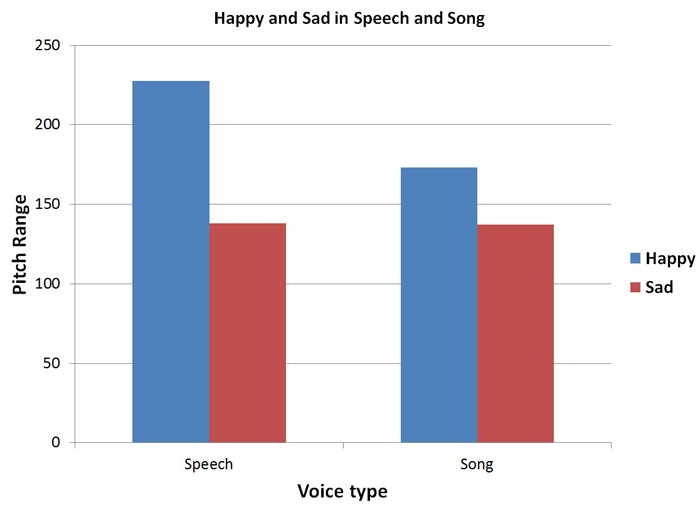The Language of Emotion: Acoustic differences in the singing and speaking voice
S. R. Livingstone – steven.livingstone@ryerson.ca
K. Peck - katlyn.peck@psych.ryerson.ca
F. A. Russo - russo@psych.ryerson.ca
Department of Psychology
Ryerson University
Toronto, Ontario
Canada
Popular Version of Paper 5aMUb
Presented Friday afternoon, June 7, 2013
ICA 2013 Montreal
Speech and song are universal forms of human expression that reflect distinct modes of communication. To the best of our knowledge, speech and song evolved between 40,000 to 250,000 years ago, and are found in every human society on the planet (Huron, 2001; Fitch, 2006; Conard et al., 2009). Some scientists believe that song and speech may once have evolved from a common origin (Brown, 2000; Mithen, 2005; Fitch, 2006). Darwin proposed that a ‘sing-song’ type of vocalization was humankind’s first language, and that one of its primary goals was the communication of emotion (Darwin, 1871).
Darwin’s hypothesis was based on the observation that song and speech, while distinct, sound remarkably similar. Darwin was not alone in this observation, as other scientists of that period had noted the two appear to express emotion in similar ways (Rousseau, 1761/1966; Helmholtz, 1863/1954; Spencer, 1875). Recently, scientists have begun to investigate the possibility that speech, song, and music may share a common ‘acoustic code’ (Scherer, 1995; Juslin and Laukka, 2003). That is, when either speaking or singing, we express a particular emotion with similar changes to the acoustics of our voices. For example, we would express ‘angry’ in both song and speech with similar patterns of spectral energy (see Fig. 1) (audio 1, audio 2).

Figure 1. Spectrograms of the sentence “Kids are talking by the door” spoken and sung in an angry voice.
However, despite their long cultural and scientific association, there appear to have been no direct comparisons of the acoustic properties of emotion in song and speech.
Our goal was to show that speakers and singers use similar changes to their vocal acoustics, when speaking or singing particular emotions.
We recorded six highly trained actors while they spoke and sung sentences with a range of different emotions (calm, very calm, happy, very happy, sad, very sad, angry, very angry, scared, very scared, and no emotion). We video and audio recorded 6 actors, each producing 88 distinct utterances (see Movie 1). We then analyzed a range of different acoustic measures from the acoustic recordings.
Movie 1. Video recordings of an actor speaking and singing with a happy emotion. Click here to view.
As hypothesized, speech and song conveyed emotions using similar changes on all of the analyzed acoustic features. For example, happy speech and song were louder, had a higher and wider pitch range, and were more energy in the higher spectral range than sad speech and song (see Fig. 2).

Figure 2. Range of pitch of the voice in speech and song, comparing happy and sad emotions.
These data confirm that speech and song express emotions in similar ways, as hypothesized. These results extend our understanding of the entwined nature of speech and song, and may provide evidence of their ancient links to a common evolutionary origin.
References
(1) Brown, S. (2000). "The" musilanguage" model of musical evolution," in The origins of music, edited by N. L. Wallin, B. Merker, and S. Brown (The MIT Press, Cambridge, Mass), pp. 271-300.
(2) Conard, N. J., Malina, M., and Münzel, S. C. (2009). "New flutes document the earliest musical tradition in southwestern Germany," Nature 460, 737-740.
(3) Darwin, C. (1871). The descent of man and selection in relation to sex (John Murray, London).
(4) Fitch, W. T. (2006). "The biology and evolution of music: A comparative perspective," Cognition 100, 173-215.
(5) Helmholtz, H. (1863/1954). On the sensations of tone (Dover New York).
(6) Huron, D. (2001). "Is music an evolutionary adaptation?," Annals of the New York Academy of Sciences 930, 43-61.
(7) Juslin, P. N., and Laukka, P. (2003). "Communication of emotions in vocal expression and music performance: Different channels, same code?," Psychological Bulletin 129, 770.
(8) Mithen, S. J. (2005). The singing Neanderthals: The origins of music, language, mind, and body (Harvard Univ Pr).
(9) Rousseau, J.-J. (1761/1966). "Essay on the Origin of Languages," On the origin of language, 5-74.
(10) Scherer, K. R. (1995). "Expression of emotion in voice and music," Journal of Voice 9, 235-248.
(11) Spencer, H. (1875). "The origin and function of music," in Fraser's Magazine, pp. 396-408.

